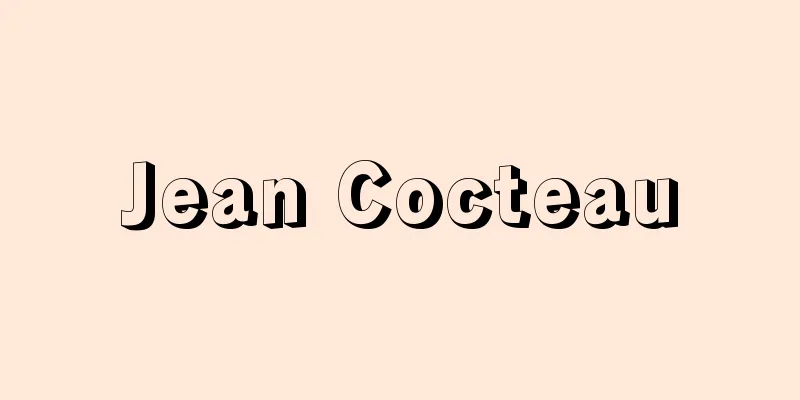Jean Cocteau

|
French poet. He was a painter, screenwriter, film director, and was involved in a wide variety of artistic activities, earning him the nickname "orchestral man." He is the author of "Watashi no Mimi wa Kai no Kara, Umi no Hibiki wo Nasshimu" (My ears are shells, I miss the sounds of the sea) (translated by Horiguchi Daigaku), a song that is widely loved in Japan. The youngest of two children, with one older sister and one older brother, he was born on July 5th in Maisons-Laffitte, near Paris, to a wealthy family that loved art and music. From an early age, he was accustomed to the atmosphere of Parisian high society, frequenting the gates of such notables as the female poet Countess de Noailles and Proust before he became a writer. He published three books of poetry between the ages of 20 and 23. However, in later years, the poet himself removed these from his catalog of works, saying that they were not creative works. After meeting novelist Gide and musician Stravinsky, he embarked on a rigorous path of self-discovery, completing the novel "Potomac" (1913-1919), a combination of drawings and prose. When World War I broke out, he joined a private organization to rescue wounded soldiers and went to the front line, writing about his experiences in his poetry collection "Cape of Good Hope" (1919), which later culminated in his novel "Thomas the Speculator" (1923). His ballet librettos, such as "Parade" (1919), with the cooperation of painter Picasso and composer Satie, and "The Bride and Groom of the Eiffel Tower" (1924), composed by the emerging musical group "La Gène des Six", astonished the world with their novelistic appeal. His critical works are diverse, including art treatises such as "The Cock and the Harlequin" (1918) and "The Profane Mystique" (1928), memoirs such as "The Diary of My Youth" (1935) and "The Umbilical Cord" (1962), meditations such as "Opium" (1930), "The Difficulty of Being" (1947), and "The Diary of an Unknown Person" (1952), as well as travelogues, observations, and essays on writers, all of which are rooted in the pursuit of beauty and poetry. After the semi-autobiographical novel "The Great Hip Opening" (1923), he published the anonymous homosexual novel "The White Paper" (1928), which attracted controversy. He then published the masterpiece "Les Enfants Terribles" (1929), and then turned away from novels to devote his passion to the stage and film. His plays, such as the modernized mythological drama "Orpheus" (1927), the monologue "Voices" (1930), "The Infernal Machine" (1934), "The Terrible Parents" (1938), "The Double-Headed Eagle" (1946), and "Bacchus" (1952), as well as films such as "Poet's Blood" (1930), "Beauty and the Beast" (1946), "Orpheus" (1949), and "The Testament of Orpheus" (1960), each of which changed his style and became controversial works dealing with the themes of love, death, and poetry. As for poetry collections, after mid-period masterpieces such as the Renaissance-style "Heijokyoku" (1922) and the exquisite wordplay "Opera" (1937), he became increasingly introspective after "Yumeishu" (Collection of Ghosts) after the Second World War, finally reaching his peak with the long poem "Requiem" (1959), which he wrote while on his sickbed after a serious illness. We must not forget his achievements as a sculptor, including many drawings, pastels, murals, and ceramics and other objects. Even after he was elected to the Academy in 1955, his creative drive did not wane, and he remained an eternal artist until the end. However, his multifaceted talent was not properly recognized, and as he himself wrote, "The public loves poets only because they misunderstand them," he could be said to have been a lonely, "unknown" poet, shrouded in a "fame of misunderstanding" throughout his life. He died in Mille-la-Forêt on October 11, 1963. [Motoyoshi Sone] Documents List of Director's Works The Blood of a Poet (1930) "Complete Works of Jean Cocteau, supervised by Horiguchi Daigaku and Sato Saku, edited by Sone Motoyoshi, 8 volumes (1980-1987, Tokyo Sogensha)" ▽ "Cocteau Poetry Collection, translated by Horiguchi Daigaku (Shincho Bunko)" [References] | | | | | | |Source: Shogakukan Encyclopedia Nipponica About Encyclopedia Nipponica Information | Legend |
|
フランスの詩人。詩、批評、小説、戯曲、バレエの台本をはじめ、画家、シナリオライター、映画監督など「オーケストラ人間」とよばれるほど多彩な芸術活動を展開した。日本で広く愛唱される「私の耳は貝の殻 海の響(ひびき)をなつかしむ」(堀口大学訳)の作者である。姉1人兄1人の末っ子として、7月5日パリ近郊メゾン・ラフィットで、美術・音楽を愛好する富裕な家庭に生まれた。幼少時からパリの社交界の雰囲気になじみ、女流詩人ノアイユ伯爵夫人、作家となる前のプルーストらの名士の門に出入りし、20歳から23歳の間に3冊の詩集を公刊した。しかし後年、詩人自身はこれらを創造的な作品でないとして自著目録から抹消した。小説家ジッド、音楽家ストラビンスキーと知り合ったころから、厳しい自己探求の道を進み、デッサンと文とで構成する小説『ポトマック』(1913~1919)を完成。第一次世界大戦が起こると民間組織の傷病兵救護団に参加して前線に出、その体験を詩集『喜望峰』(1919)に歌い、後の小説『山師トマ』(1923)に結実させた。画家ピカソ、作曲家サティの協力を得た『パラード』(1919)、新興音楽グループ「六人組」の作曲による『エッフェル塔の花嫁花婿』(1924)などのバレエ台本は新奇な魅力で世間を驚かせた。批評には『雄鶏(おんどり)とアルルカン』(1918)、『世俗な神秘』(1928)などの芸術論、『わが青春記』(1935)、『へその緒』(1962)などの回想記、『阿片(あへん)』(1930)、『存在困難』(1947)、『知られざる者の日記』(1952)などの省察録のほか、旅行記、見聞録、作家論など多様で、すべては美とポエジーの追究に帰一する。 小説では半自伝風の『大胯(おおまた)びらき』(1923)のあと、著者名を伏せた同性愛の『白書』(1928)を出版して論議をよび、やがて名作『恐るべき子供たち』(1929)を発表後は、小説から離れて舞台と映画に情熱を傾け、現代化した神話劇『オルフェ』(1927)、独白劇『声』(1930)、『地獄の機械』(1934)、『恐るべき親たち』(1938)、『双頭の鷲(わし)』(1946)、『バッカス』(1952)などの戯曲、『詩人の血』(1930)、『美女と野獣』(1946)、『オルフェ』(1949)、『オルフェの遺言』(1960)などの映画は、それぞれ作品のスタイルを変化させつつ、愛と死と詩を主題にした問題作となった。 詩集としては、ルネサンス風な『平調曲』(1922)、絶妙な言語遊戯の『オペラ』(1937)などの中期の名作を経て、第二次世界大戦後の『幽明集』以後しだいに内観的となり、大患の病床でつづった長詩『鎮魂歌』(1959)で、ついに頂点に達した。 多くの素描、パステル画から壁画まで、また陶器その他のオブジェ作者としての活動も含めて、造形作家としての業績も忘れてはならない。アカデミー会員に選出(1955)後も創作意欲は衰えず、最後まで永遠の芸術家だったが、あまりに多角的な才能は正当に評価されず、彼自身「大衆は誤解によってのみ詩人を愛する」と書いたように、終生「誤解の名声」に包まれた「知られざる」孤独な詩人であったといえる。1963年10月11日ミリ・ラ・フォレに没。 [曽根元吉] 資料 監督作品一覧詩人の血 Le sang d'un poète(1930) 『堀口大学・佐藤朔監修、曽根元吉編『ジャン・コクトー全集』全8巻(1980~1987・東京創元社)』▽『堀口大学訳『コクトー詩集』(新潮文庫)』 [参照項目] | | | | | | |出典 小学館 日本大百科全書(ニッポニカ)日本大百科全書(ニッポニカ)について 情報 | 凡例 |
Recommend
Motor end-plate
…In the case of striated muscles, each muscle cel...
Osaka College of Music
A private single-discipline university. Its predec...
Karakul [seed] - Karakul
…The fur of newborn karakul lambs from the Astrak...
Antagonist muscle
Antagonism refers to two muscles or muscle groups ...
Aristocrat - Kizok
A group that is socially and traditionally recogn...
Musical tales - Ongyokubanashi
〘Noun〙 A type of rakugo storytelling that incorpor...
Otaniyama Tomb No. 22 - Otaniyama 22nd Tomb
...What made Iwahashi Senzuka famous was the uniq...
Wadi - Waji (English spelling)
The name means river valley in Arabic, but it is ...
Archaeosperma - Archaeosperma
...They were also called cycad ferns because they...
Sake cup - Ochoko
...It is a type of cup, usually a small ceramic v...
Seven Entrances of Kamakura
Seven entrances to Kamakura. Nagoshi Calm・Asahina・...
Santorini (island) (English spelling)
A volcanic island in the Cyclades in the Aegean Se...
Nāsik - Nāsik (English spelling)
A city in northwestern Maharashtra, western India...
Liverpool Manchester Railway - Liverpool Manchester Railway
This was the world's first railway on which a ...
Kurozumikyo - Kurozumikyo
A Shinto religious organization. One of the thirt...
![Agfa-Gevaert [company] (English spelling) Agfa-Gevaert](/upload/images/67cad20d2c139.webp)








